Reading Infield Hops
An infielders’ ability of reading infield hops will greatly enhance their fielding percentage as it reduces, and hopefully eliminates, the chances of facing the infamous in-between hop.
Teaching the fundamentals of fielding ground balls, the foot movement and distances of spread, bending of the knees, glove positioning out in front and low to the ground, etc. demands time, patience and practice, and with all the other skills needed to learn, schooling on fielding ground balls pretty well stops there.
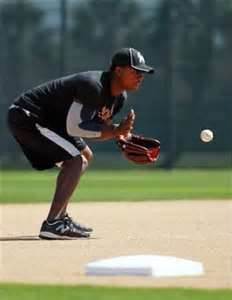
High Hop
Reading Infield Hops
Since I’m not bound to a practice time limit, I can delve into and teach you the little tricks of trade which will help you take your players to the next level. Let’s begin our lesson.
Ground ball hops essentially fall into one of three categories, which are the “High Hop,” the “Low or Short Hop,” and the treacherous “In-Between Hop,” which all infielders try to avoid. The sooner an infielder identifies what type of ground ball will most likely result as it comes off the bat, the sooner he can put his body into motion in order to get into the most advantageous fielding position possible in which to catch the ball.
The First Hop is the Key!
What the baseball does as it comes off the bat, hits the ground and the initial bounce it takes from the ground, will determine the type of hop it will continue to take unimpeded.
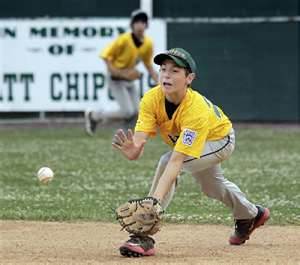
Playing Low Hop
Reading Infield Hops
High Hop: A bounce does not have to be chest high in order to be classified as a high hop, but rather a bounce anywhere between just below the knees to under the arm pits is considered a high bounce, and the most desirable bounce to get due to their ease of fielding.
The rule of thumb is “If the first bounce is high, the infielder is to come forward and attack the ball, as it will continue to bounce high.”
Why would you come forward instead of waiting for the high hop to come to you? Several reasons:
(1.) Moving forward puts the body into motion, from which you can easily and quickly adjust to any height or direction change of the baseball making fielding it easier for you.
(2.) Never allow the baseball “To Play You,” which means you must react and adjust quickly according to the ball’s reaction, dictating how you must try and field the ball, instead of you deciding which hop you field the ball on. This rule applies to ALL ground balls, not just high hoppers.
(3.) Should the bounce be slow and the batter fast, the runner may very well beat the throw to the base if you wait for the ball to travel to you instead of closing the gap by moving forward.
Clickbank Products
What is considered a high hop off the bat? That’s an excellent question and without sounding like a cop out, it depends. Basically speaking any ball which bounces 6” to 8” high on the first hop will result in a high hop, but that can, at times, be affected by the spin and the speed of the ball.
Instinct and experience is your best form of analyzing whether it’ll be a high hop or not and that can only be obtained by fielding hundreds, if not thousands of ground balls, but for all practical purposes the 6”-8” rule is correct 98% of the time.
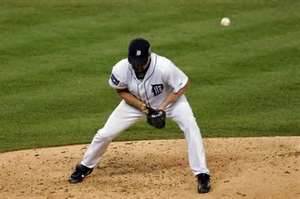
Misreading Hop
Reading Infield Hops
Short or Low Hops: This type of ground ball travels at a low trajectory to the ground and unimpeded, takes true bounces, therefore it’s relatively easy to field cleanly.
Again, the initial bounce off the bat identifies what type of bounce it’ll be, and this ball will scoot or stay very low to ground as it travels. Once identified the infielder moves into position, whether in or to either side, in order to field the ball, and approaches the ball low. It’s important to keep the glove lower than the ball, allowing the ball to enter the glove as it’s moved forward and up in order to retrieve the ball.
Watch the ball all the way into the glove, as guessing as to when to begin to bring the glove forward and up, will most likely result in the ball scooting underneath the glove and traveling into the outfield.
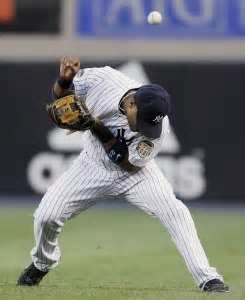
In-Between Hop Results
Reading Infield Hops
In-Between Hop: There are times a hitter will hit the ball so hard and it’s on the fielder so fast, there is no time to move much alone analyze, and the ball will reach the fielder while he is in no pre-determined fielding position to catch the ball.
For instance a low screaming line drive which bounces 2’ to 3’ in front of the infielder and stays low after the bounce, will force the fielder’s weight back onto his heels, which prevents him from bending over or making any other conscious effort to catch the ball. In other words, if he catches the ball it was sheer luck, not skill.
However, this type of hop constitutes perhaps 1% to 2% of in-between hops, the remaining 98% are caused by fielder indecision. If an infielder is unable to determine the hop and speed of the ball coming off the ground, as the ball comes off the bat, he may hesitate moving, thus freezing body motion.
By not moving the infielder has put himself into the position of “Being Played By The Ball,” sound familiar, which is the last place any fielder wants to find themselves. This is what has happened:
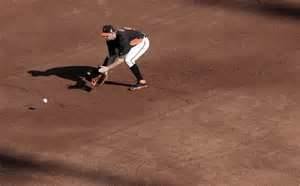
Playing Low Hop
Reading Infield Hops
The ball turned out to be a high, knee high, hop, but because the fielder was not moving forwards the last hop the ball takes before reaching the fielder happens 2’ in front of him. His weight is back on his heels and his mobility, the ability to move and field the ball, other than falling backwards, is zero.
The same principles apply to a short or low hop. When in doubt … move.
Quick Review:
(1.) Read the ball as it comes off the bat …
(2.) First hop 6” to 8” high indicates a High Hop …
(3.) First hop scoots or hugs the ground, indicates Low or Short Hop…
(4.) Always be moving towards the baseball, never be caught Flat Footed.
Reading Infield Hops to Infield Drills

New! Comments
Have your say about what you just read! Leave me a comment in the box below.